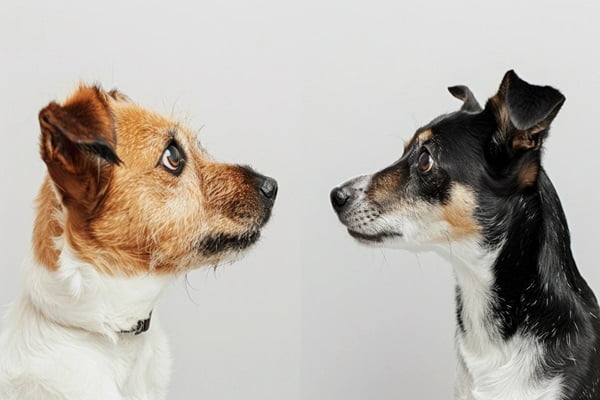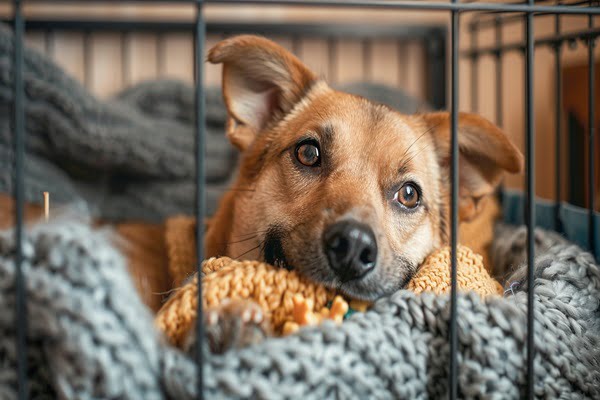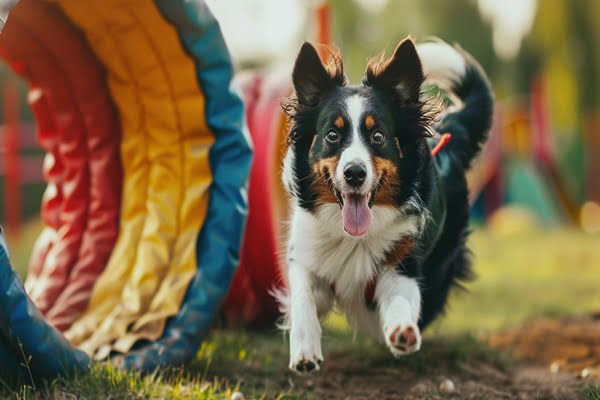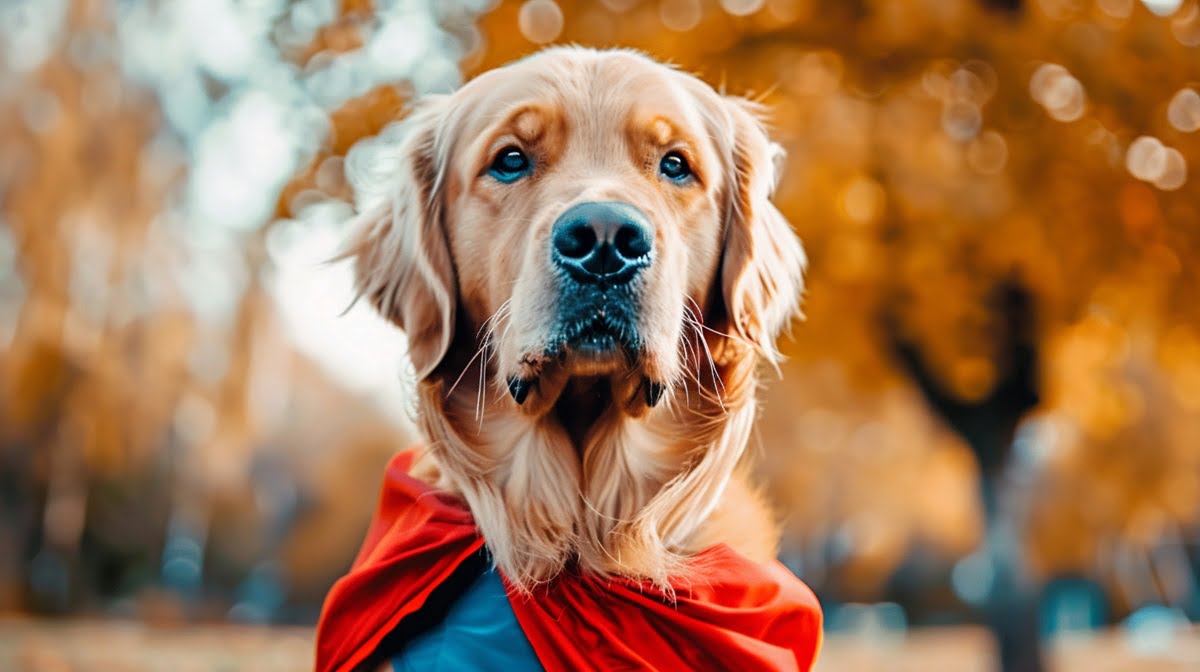Have you ever seen a dog cower in the corner during a thunderstorm or shy away from a friendly stranger? Perhaps your own furry companion struggles with meeting new dogs at the park or balks at the sight of the vet’s office. This hesitancy and fear, often stemming from a lack of confidence, can significantly impact a dog’s quality of life.
But here’s the good news: even the most timid of pups can transform into courageous canines. Confidence-building isn’t just about overcoming fears; it’s about empowering your dog to thrive in any situation, forging a deeper bond between you, and unlocking their full potential for joy and adventure.
In this comprehensive guide, we’ll delve into the fascinating world of canine confidence. We’ll explore the signs of both confident and insecure dogs, unravel the science behind their emotions, and equip you with a treasure trove of vet-approved strategies, engaging games, and even some unique, lesser-known techniques to unleash your dog’s inner hero.
Understanding Dog Confidence: Decoding the Canine Mindset

What is Dog Confidence?
A truly confident dog is not simply fearless. True confidence is a state of emotional well-being, marked by an ability to navigate various situations with resilience and adaptability. It’s the difference between a dog who shrinks back in fear at the sound of a car horn and one who curiously observes it, remaining calm and collected.
The Confident Canine: A Closer Look
A confident dog exhibits several telltale signs:
- Body language: A relaxed posture with an upright tail, soft eyes, and open mouth (panting without stress). They may also engage in “play bows” to initiate friendly interactions.
- Behavior: Confident dogs are curious explorers, eager to investigate new sights and smells. They interact calmly with other dogs and people, demonstrating appropriate social skills.
- Emotional resilience: They recover quickly from startling events and adapt well to changes in routine.
Signs of Insecurity
Insecure dogs often display the following behaviors:
- Body language: A tucked tail, hunched posture, lowered head, and ears pinned back. They may avert their gaze or lick their lips excessively.
- Behavior: Insecure dogs may cower, hide, or tremble in response to perceived threats. They might show aggression out of fear or avoid interacting with other dogs and people.
- Emotional reactivity: They may overreact to minor stimuli and struggle to calm down.
The Science of Canine Emotions
Understanding the science behind canine emotions can shed light on why some dogs lack confidence. Fear and anxiety are rooted in the dog’s limbic system, which processes emotions and triggers fight-or-flight responses. These emotions can be triggered by various stimuli, including loud noises, unfamiliar environments, or negative past experiences.
Building Resilience: The Key to Confidence
A unique aspect of confidence is resilience – the ability to bounce back from setbacks. Resilient dogs view challenges as learning opportunities rather than threats. By fostering resilience, we can help our dogs develop the mental fortitude to face life’s uncertainties with confidence.
Foundational Building Blocks for Confidence: Nurturing a Secure and Happy Dog

Building Confidence Through Positive Reinforcement
Positive reinforcement is the cornerstone of confidence-building for dogs. It’s the simple yet powerful act of rewarding desired behaviors, creating a positive feedback loop that encourages your dog to repeat those actions. This approach not only strengthens the bond between you and your dog but also fosters a sense of trust and security.
When your dog exhibits a confident behavior, such as approaching a stranger calmly or staying relaxed during a car ride, offer them a treat, a heartfelt praise, or a favorite toy. This positive association helps them understand that these actions lead to enjoyable outcomes, reinforcing their confidence over time.
Establishing Predictable Routines
Dogs thrive on routine. A structured schedule provides them with a sense of predictability and control, reducing anxiety and promoting confidence. Set consistent times for meals, walks, playtime, and training sessions. This predictability can be particularly beneficial for dogs who struggle with separation anxiety or fear of the unknown.
Creating a Safe Haven
Every dog deserves a sanctuary where they can retreat and feel safe. This could be a crate, a designated bed, or a quiet corner of your home. Fill this space with comfortable bedding, familiar toys, and perhaps even a calming pheromone diffuser. Encourage your dog to use this safe haven when they feel overwhelmed or need a break.
Positive Socialization: Building Confidence Through Interactions
Socialization plays a pivotal role in shaping a dog’s confidence. Introduce your dog to a variety of people, dogs, and environments in a positive and controlled manner. Focus on creating positive associations with new experiences. If your dog is shy or fearful, start with slow and gentle introductions, rewarding them for calm behavior.
Desensitization and Counterconditioning: Tackling Fears Head-On
If your dog has specific fears or anxieties, such as fear of loud noises or car rides, desensitization and counterconditioning can be game-changers. These techniques involve gradually exposing your dog to the trigger in a controlled setting while pairing it with positive experiences like treats and praise. Over time, the fear response is replaced with a positive association, leading to increased confidence.
Empowerment Training: Unleashing Your Dog’s Inner Decision-Maker
A unique approach to confidence-building is empowerment training. This innovative method involves teaching your dog to make choices and control their environment. For example, you could teach them to nose-target a bell to go outside or touch a specific object to request playtime. This sense of agency can significantly boost their confidence and independence.
Confidence-Boosting Games and Activities: Beyond the Basics

Unleashing Fun and Focus: Scent Work and Nose Games
Harnessing a dog’s innate sense of smell can be incredibly empowering. Scent work engages their minds, builds confidence in their natural abilities, and provides a healthy outlet for their energy.
- Basic Hide-and-Seek: Start by hiding treats or toys around the house or yard and encourage your dog to find them.
- Advanced Scent Discrimination: Train your dog to distinguish between different scents. Start with two distinct smells and gradually increase the complexity.
- Container Searches: Hide treats in boxes or containers with varying levels of difficulty. This challenges their problem-solving skills and boosts confidence when they succeed.
Agility Training: A Playground for Confidence
Agility courses aren’t just for competition; they’re a fantastic way for dogs of all ages and abilities to build confidence, improve physical coordination, and strengthen the bond with their handler.
- Backyard Agility: Create a simple course with tunnels, jumps, and weave poles using household items or affordable DIY kits.
- Professional Courses: For more experienced dogs, consider enrolling in agility classes with a certified trainer.
- The Confidence Boost: Completing obstacles successfully, under your guidance, reinforces your dog’s trust in you and their own abilities.
Trick Training: Building Confidence Through Skill Acquisition
Teaching your dog tricks is not just about showing off at parties. It’s a powerful confidence-builder that strengthens the human-canine bond and enhances their cognitive abilities.
- Start Simple: Begin with easy tricks like “sit pretty” or “shake paw.” Use positive reinforcement to mark correct responses.
- Increase Complexity: Gradually introduce more challenging tricks like “roll over” or “play dead.”
- Get Creative: Explore unique tricks tailored to your dog’s personality and interests.
Clicker Training: Precision and Positivity
Clicker training is a highly effective method for shaping precise behaviors and improving communication with your dog. The clicker sound acts as a marker, indicating the exact moment your dog performs a desired action. This immediate feedback fosters clarity and accelerates learning, leading to increased confidence in their ability to understand and respond to your cues.
Free Shaping: Encouraging Creativity and Initiative
Free shaping is a fun and engaging way to encourage your dog to think creatively and offer behaviors spontaneously. Instead of luring or prompting them, observe their natural movements and reward any actions that resemble the desired behavior. This approach allows them to explore their capabilities and discover new ways to interact with the world.
Adventure Walks: Exploring New Horizons
Taking your dog on regular walks is essential for their physical and mental well-being, but consider adding a twist. Explore new environments, such as different parks, trails, or even urban settings. Introduce them to novel sights, sounds, and smells while ensuring their safety and comfort. These adventures will broaden their horizons, expose them to new experiences, and ultimately build confidence in unfamiliar situations.
Unique Confidence-Boosting Activities:
- Canine Parkour: Introduce your dog to the exciting world of urban agility, navigating obstacles in everyday environments like benches, stairs, and low walls.
- DIY Confidence-Boosting Toys: Create interactive toys that challenge their problem-solving skills, such as treat puzzles with hidden compartments or homemade snuffle mats.
- Confidence-Building Classes: Enroll your dog in specialized classes designed to address specific anxieties or fears, such as shy dog or reactive dog classes. These classes provide a supportive environment for building confidence under the guidance of experienced trainers.
By incorporating these diverse activities into your dog’s routine, you’ll create a well-rounded confidence-building program that caters to their individual needs and interests.
FAQ
Can a dog’s breed influence their confidence level?
While genetics play a role, a dog’s confidence is primarily shaped by their environment and experiences. Certain breeds may have predispositions, but proper socialization and training can build confidence in any dog.
How long does it take to see significant improvements in my dog’s confidence?
Progress varies depending on the dog’s age, temperament, and the severity of their anxieties. With consistent effort and positive reinforcement, you might notice subtle changes within weeks, but substantial improvements could take months or even years.
Is it ever too late to start confidence-building with an older dog?
Absolutely not! While early socialization is ideal, older dogs can still learn and overcome anxieties. Patience, positive reinforcement, and a tailored approach are key to success.
Can certain foods or supplements boost my dog’s confidence?
A balanced diet rich in essential nutrients is crucial for overall well-being, which can indirectly affect confidence. Certain supplements like probiotics or calming herbs may help in specific cases, but always consult your veterinarian for guidance.
What’s the difference between a confident dog and a dominant dog?
Confidence stems from emotional security, while dominance relates to social hierarchy. A confident dog is assertive but not aggressive, respecting boundaries and interacting appropriately with others. A dominant dog may display pushy or controlling behaviors.

My job is to make sure every fact is right and every article is a joy to read. I’m kind of like a dog trainer for information – I make it behave!

